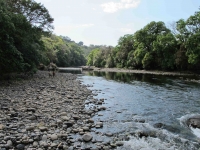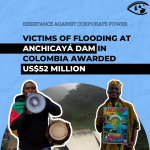Tabasará River Communities Struggle to Halt Panamanian Dam Project

High up on a hill above the indigenous Ngäbe community of Kiad in the western Panamanian province of Chiriqui, the river Tabasará can be seen shimmering in the mid-morning heat. Surrounded by cattle pastures on one side and tropical dry forest on the other, the river winds like a blue-green serpent from the remote mountainous region of the Comarca Ngäbe-Buglé southward towards the Pacific Ocean, until a construction site comes into view.
A mass of steel rods, grey concrete blocks, and exposed red earth marks where Honduran owned Generadora del Istmo S.A. (GENISA), is constructing the 28.84 megawatt Barro Blanco hydroelectric project. It is scheduled to be completed within a year.
Just meters from the river, in the Latino farming community of Nancito, is the home of Marìa Quijada, a diminutive campesina (subsistence farmer) in her seventies. It is a modest wooden structure that sits nestled on the riverbank surrounded by lemon, orange, chilli, and wild cashew trees. When the dam is completed, it will be inundated by a 258 hectare reservoir together with six homes in nearby Kiad.
 Earlier this year, she invited this writer to visit. Setting down a bowel of fresh red, plump river shrimp caught by hand as is tradition,Quijada invited everyone to eat. These crustaceans and other species of shrimp and fish are at risk of disappearing if the dam is completed.
Earlier this year, she invited this writer to visit. Setting down a bowel of fresh red, plump river shrimp caught by hand as is tradition,Quijada invited everyone to eat. These crustaceans and other species of shrimp and fish are at risk of disappearing if the dam is completed.
"I have raised my kids here, ten kids here, in this very same place, swimming in this river, fishing, and hunting and here all were raised... To what place [will we go]? To where? We will be like birds without a nest," she said. "The Tabasará River is for everyone, animals, people, and everything. It is a very beautiful river (so) why does [GENISA] want to take away our river?"
Damming the Ngäbe-Buglé
Bordering Nancito is the Comarca Ngäbe-Buglé. In 1997, after a long struggle, the Comarca, a semi-autonomous region, was created by the Panamanian government and is protected by a law that deems all land inside it to be collectively owned by the local indigenous communities under "unalienable" rights.
The land was awarded to the Ngäbe and the culturally similar but linguistically distinct Buglé indigenous people. Some 150,000 of the country's 200,000 Ngäbe live in the Comarca which encompasses 6,968 squares kilometres of land, with three regions and seven districts.
In 1999, Ngäbe activists were jailed on April 10 for demonstrating against the Tabasará I, a proposed 48 megawatt dam, birthing a local activist group named M10. After years of activism, the original project was abandoned.
But the plan never went away - after all some 60 percent of Panama's power is generated through hydroelectricity which gives the industry enormous clout in the country. Indeed, this past May, Panama made international news when the government closed schools and businesses after a longer than expected dry season caused an 'energy crisis.'
In 2006, the project was re-invented as Barro Blanco and a concession was awarded to GENISA by the government. To date, the project has received a total of $78.3 million in financing from loans granted by three development banks: the Dutch Entrepreneurial Investment Bank (FMO), the German Development and Investment Corporation (DEG), and the Central American Bank for Economic Integration (CABEI).
In 2007, the company performed a mandatory Environmental Impact Assessment (EIA) which was approved by ANAM, the country's environmental agency, in 2008.
It was also approved under the United Nation's Clean Development Mechanism (CDM) in 2011 as a greenhouse gas emission reduction project, because hydropower is believed to causes less climate change than fossil fuels. As a result, GENISA can now trade Certified Emission Reduction units (CERs), also known as "carbon credits," under the international carbon trading scheme.
Construction work began in February 2011.
According to GENISA's 2011 "Environmental and Social Summary Report" none of the land which will be inundated is used for cultivation and no local communities are to be impacted.
But indigenous Ngäbe and campesino communities maintain that the project will indirectly and directly impact 5,000 people, inundating homes, cultivable land, several hectares of gallery forest and important cultural centres and archaeological sites. They say they will also lose the use of the river for fishing, bathing, and swimming for which they have not been offered any compensation.
They also say they were not consulted by the Spanish Association for Standardization and Certification (AENOR) when it evaluated the project for carbon credits.
"I haven't talked to anyone, no. [GENISA] never came to speak or talk or offer anything regarding the dam, nothing," Nicolas Castillo an old campesino man whose face is bronzed and arms muscular from many years of working the land, told CorpWatch.
For its part, ANEOR's validation report flatly contradicts the claim that none of the indigenous stakeholders were consulted.
This may explain why there is no mention of the dam's impact on the local community in any of GENISA's reports such as on fishing activity.
Activists say this is a serious omission. Oscar Sogandares of the environmental group Asociación Ambientalista de Chiriqui, who works in solidarity with the Ngäbe and campesino communities, explains that many Tabasará river species are migratory - they travel between the mouth of the river and the upper reaches of the mountains in order to breed.
If the dam is completed, he says it will create a significant barrier for fish and crustaceans, resulting in a loss of these species and for the communities that depend on them.
United Nations Assessment
In March 2012, the Ngäbe shut down the Pan-American Highway with several days of anti-mining and hydroelectric protests, causing the country to come to a standstill with dozens injured and two demonstrators allegedly killed by police.
Eventually the government and the Ngäbe leadership signed the San Lorenzo Peace Accords which called for a United Nations led "Field Verification Mission" that visited the three Ngäbe communities of Nuevo Palomar, Kiad, and Quebrada Caña.
On the last day of their visit over 80 campesinos, feeling ignored by GENISA and the government, descended upon the UN delegation to have their voices heard. Leading the group of indignant campesinos was Enrique Alvarez, a cattle rancher who had refused to sell his land to GENISA.
Alvarez tells CorpWatch that other landowners had sold to GENISA for $3,000 per hectare, which he considers a meager amount. GENISA, together with the assistance of Panama's National Authority for Public Services (ASEP), initiated legal proceedings in order to acquire the land under laws that allow them to take lands for any project deemed to be of "social interest."
"Well, they're accusing us, saying that we didn't want to negotiate, and if we didn't want to negotiate with them then they said we're going to receive whatever the government says, it is something minimal."
According to an ASEP document supplied by a Panamanian environmental law organisation, Centro de Incidencia Ambiental de Panama (CIAM), GENISA initiated requests for the "compulsory acquisition" of land belonging to Alvarez and six others in August 2012. This included land belonging to five Ngäbe families located within the Bagama district of the Comarca Ngäbe-Buglé. GENISA maintains that most of land purchased for the project is not suitable for cattle farming or agriculture.
Also, according to the EIA - which was conducted for a 19 megawatt dam with a 42 meter wall that would flood 243 hectares - only 6.7 hectares of land within the Comarca will be affected.
But in 2008, the dam's capacity was hiked to 28.84 megawatts, and plans for the wall were revised upwards to 60 meters.
Now Sogandares says the dam will affect at least 7.4 hectares of land within the Comarca and even the UNDP report underestimates the potential impact because it is based upon the minimum flood level of 103 meters above sea level. In reality much more land together is at risk of being inundated if the maximum flood level, which is 108.25 meters above sea level, is reached - including households in Kiad, Quebrada Caña, and Nuevo Palamar.
The one thing that the United Nations report did call to attention - unlike GENISA'S EIA - was the potential impact of the dam on fishing, perhaps because they actually met the local community.
Ignored by Dam Builders
In June 2013, the long awaited independent expert study to assess the impact of the project, stipulated in the San Lorenzo Peace Accords, began. But much to the communities' frustration, construction work has continued unabated and faith in the UN process is waning. On June 10, Ricardo Miranda of the M10 movement told national newspaper, La Prensa, that "[M10] reject this study because it is said that it should end in a negotiation [for compensation] but we do not want that."
In July, the Tabasará communities received a visit from James Anaya, the United Nations Special Rapporteur on the Rights of Indigenous Peoples and on July 26, in a press statement, he urged for the government and the Ngäbe to resume talks.
Anaya also acknowledged that the government had failed to properly consult the communities stating that "[GENISA] has an independent obligation to respect those rights, according to the 'Guiding Principles on Business and Human Rights' approved by the Human Rights Council in 2011."
Protests Met by Militarization
As the Ngäbe community has escalated its protests and brought international attention to the project, the government has increased its reprisals.
For example, in 2011, after Panamanian and international activists and environmental groups prompted the European Investment Bank, one of Barro Blanco's original financiers, to carry out an investigation into alleged human rights abuses, GENISA withdrew its funding request.
In 2012, Rain Forest Rescue, a German NGO, initiated a letter campaign that generated 40,000 protest letters to DEG, the German funders.
In March 2012, local activists shut down the Pan-American Highway to protest the dam which was met with violence. Three people were killed by police bullets.
CorpWatch met with Luis Jimenez who says that when he joined the protest he was shot in the leg with a rubber bullet by police. Struggling to walk, Jimenez sits down on a bench and rolls up his trouser leg, revealing a nasty scar. "I can't work, I can't walk and I have a family that depends on me for everything," he says.
This past January, Silvia Carrera, the Cacica General (general chief) of the Comarca Ngäbe Buglé, joined the M10 activists to stage a peaceful protest which was immediately broken up by police dispersing tear gas.
Two months later, heavily armed riot police arrested demonstrators at a protest camp in the town of Vigui, close to the dam site, and allegedly used tear gas, and rubber bullets to disperse the group.
Then on March 22 - World Water Day - the situation turned even uglier when Onesimo Rodriguez, a Ngäbe community leader and M10 member, was found murdered in the nearby town of Cerro Punta in Chiriqui, after attending a rally against Barro Blanco where they were allegedly attacked by four masked assailants.
The militarization has alarmed international supporters.
In March 2013, a coalition of groups - International Rivers, Carbon Credit Watch and Panamanian based NGO, Alianza para la Conservación y el Desarrollo (ACD) -submitted a letter to the United Nations Framework Convention on Climate Change highlighting the increased militarization of the Barro Blanco dam area as an example of human rights impacts of carbon development mechanism projects.
CorpWatch attempted to contact GENISA as well as the funders of Barro Blanco to ask them for their response to the Ngäbe complaints and protests. GENISA did not write back to several email requests but two of the banks did reply.
"We are not of the opinion that this project is not respecting the rights of local communities," Paul Hartogsveld of FMO, the Dutch funders, wrote in an email. "The company has committed to engage constructively with the communities to address the concerns and come to solutions." He added that nothing in the UNDP report would "imply the need to withdraw our finance."
Reiterating much of information available on GENISA's website, Anja Strautz from the DEG said in an email that "The environmental and social impacts of the project are locally limited and are taken into account by GENISA within the context of its environmental and social management."
Asking the Banks to Reconsider
Local activists say the banks need to reconsider.
Earlier this year Manolo Miranda, an M10 leader and schoolteacher, and Italo Jimenez, M10's president, took me on a visit to the banks of the Tabasará. It was a cloudless day, the fierce sun reflecting of the surface of the water and a gentle breeze rustling the leaves of the trees.
Jimenez begins to wave and point animatedly; he spots several large fish, "robalo," a species of snook. "All of this great beauty is going to be lost and the government and the company say false things they don't come to this place but we are placed to confront them and defend this resource."
"The impacts are going to be extremely negative for the Ngäbe and campesino populations of the Comarca... I say to the different banks, please gentlemen; economy does not come before the environment, before the impacts."
- 183 Environment



